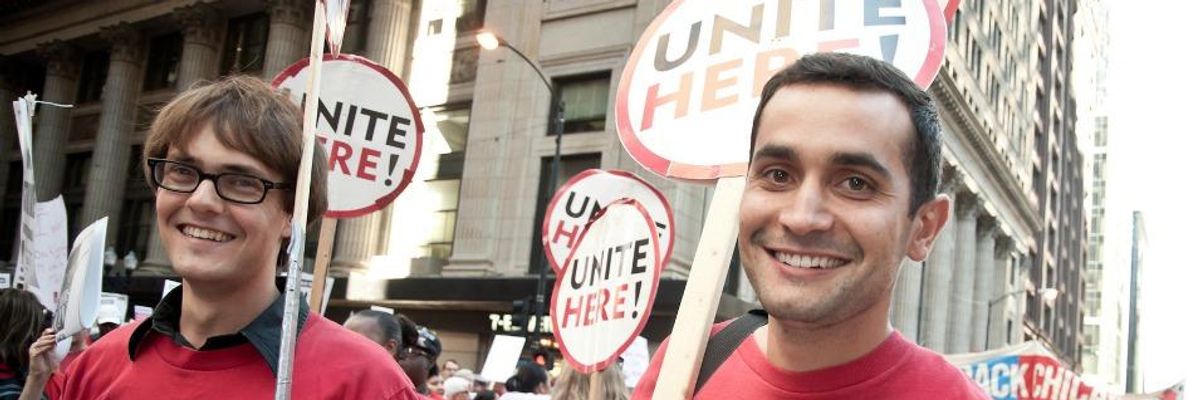The attack on the U.S. labor movement just sharpened with the Harris vs. Quinn Supreme Court decision, aimed at the heart of concentrated union power -- public sector unions. When you add in the Obama-led assault on public school teachers unions and the Koch brother-funded "Right to Work" laws, the labor movement appears to be facing imminent ruin.
At the same time, however, a powerful counter-force has emerged: the union movement has won significant victories around the fight for $15 minimum wage in Seattle and
Los Angeles, and is poised to win in San Francisco where the strongest measure yet is headed for the November ballot. These wins and prospective wins have sent shock waves through the country, showing what's possible if unions and community groups take the initiative and focus on inspiring demands that resonate through the broader community.
The 2012 the Chicago teachers' strike set an equally powerful example for unions, which has been
studied by unionists across the country. Chicago teachers re-taught the labor movement the importance of the strike and the prerequisite internal democratic organization of union members. Once organized internally, members rallied community groups and the broader population over popular demands like stopping school closures.
These advances for unions in the face of intensifying corporate attacks are forcing labor relations to a crescendo. Organized labor has, at long last, realized that fighting back is their only salvation. The tension inherent in this dynamic is volatile, and will inevitably explode as corporations relentlessly attempt to boost profits at the expense of workers' wages and benefits.
The above examples of labor's involvement in the 'Fight for $15' and the Chicago teachers' strike encapsulates all that unions need to do to re-gain their lost status as organizations that represent the broader working class, as they did to a significant extent in the 1930s, the 1940s, and the 1950s. The strategy is simple: workers inside unions need to be organized and inspired sufficiently to be able to strike, if necessary, while simultaneously fighting for demands for the broader community, like the $15 minimum wage.
Unions do not need flashy gimmicks or to re-invent the wheel. Of course, technological advances must be used while new demands and creative forms of protest should be experimented with, but Twitter and Facebook cannot replace face-to-face organizing and collective action, only complement it.
For years union leaders convinced themselves that "strikes don't work," based on the many that were misled and then lost. Instead union leaders searched in vain for labor's equivalent to the philosopher's stone, that magic "something" that would save the labor movement if only it were discovered. Since nothing "new" was discovered, in practice union leaders resorted to making backroom concessionary deals with politicians and corporations, and labor's power slid further into the mire.
And while many unions seem intent on breaking out of this organizational-political straitjacket, others seem suicidally comfortable repeating the same failed tactics.
For example, there is no reason that organized labor should not immediately put the $15 minimum wage up for a statewide referendum in all 24 states that have the ballot initiative process. The ballot initiative should also be used to raise taxes on the rich and corporations so that cuts to services and education can be prevented and reversed, and to create more public sector jobs building roads, fixing infrastructure, etc.
The only reason this isn't being done everywhere is because some labor leaders still have a "partnership" with Democratic politicians who are adamantly against the $15 minimum wage, not to mention opposing taxing the rich and corporations. These labor leaders still believe, delusionally, that they can get more from politicians than they could get by going over their heads, directly to voters.
An additional barrier that unions need to overcome in utilizing the full strength of the ballot initiative is the idea of using ballot measures as bargaining chips, where unions use the threat of progressive ballot initiatives to pressure politicians to make union-specific concessions.
For example, in Oregon SEIU filed for progressive taxation ballot measures that were later withdrawn, ostensibly in exchange for the right wing to drop their Right to Work initiative, a "deal" which was brokered by a Democratic governor.
This union "strategy" was also mentioned by the president of the United Healthcare Workers of SEIU, Dave Regan, in his "
Live Better Together" proposal for the labor movement.
And while Regan's proposal contains many good ideas, the "ballot initiative as bargaining chip" isn't one of them. The anti-union Bloomberg website made several good points in attacking the tactic:
"...But, of course, this strategy is not free for the SEIU, either; you can spend a lot of money on fake initiatives, have your bluff called, and end up with no money and no more members."
More importantly, using populist ballot initiatives as bargaining chips unfairly raise expectations for the broader community, which then gets upset when the initiatives are removed in exchange for something that appears to benefit union members only, as was done in Oregon. Lastly, fake ballot initiatives do not mobilize union members or the community at large, and resorting to backroom dealing with politicians inspires nobody.
The years of bad habits that unions have accumulated can be shed quickly, but not if the process is done bureaucratically, behind closed doors and without the involvement of rank-and-file members and community allies. Most unions still have a long way to go to actively engage their memberships like the Chicago teachers have done. But without the buy-in from rank-and-file members, a union is a paper tiger in a time where the real thing is needed.
Ultimately a union without an actively engaged membership that fails to connect with the broader community will not survive the corporate onslaught. And any labor leader that stops the process of internal union democratization and external community mobilization is destined to be exposed as incompetent, unable to lead labor out of this period of crisis.




